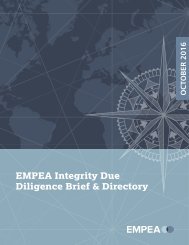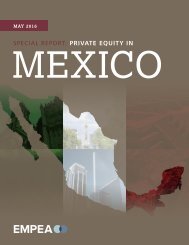You also want an ePaper? Increase the reach of your titles
YUMPU automatically turns print PDFs into web optimized ePapers that Google loves.
4. ROLE OF DONORS AND<br />
TECHNICAL ASSISTANCE<br />
PROGRAMMING<br />
Two broad conclusions can be derived from the previous<br />
sections as regards the role <strong>of</strong> donors.<br />
First, there is high potential associated with investment by<br />
PE funds in smaller enterprises in Africa. PE fund managers<br />
fully recognise the imperative <strong>of</strong> enhancing the contribution<br />
<strong>of</strong> the PE industry to servicing<br />
smaller enterprises. However,<br />
here they are confronted with<br />
a classic market-failure.<br />
General partners (GPs)<br />
face a dilemma in servicing<br />
small enterprises in that the<br />
identification / search costs<br />
(<strong>of</strong>ten hampered by weak<br />
accounting / reporting),<br />
investee company preparation<br />
costs (enterprise restructuring,<br />
Source: EMPEA.<br />
including governance<br />
and management) and<br />
investee company monitoring costs (<strong>of</strong>ten entailing close<br />
involvement in key decisions as well as quite intrusive<br />
micromanagement, such as oversight <strong>of</strong> cash-flows) tend to<br />
be as high or higher for small enterprises compared to more<br />
established enterprises. GPs are unable to fund these high<br />
fixed costs from the industry-wide standard 2% <strong>of</strong> capital<br />
that is devoted to the GP’s annual management fees.<br />
As a result, the focus <strong>of</strong> the PE industry invariably drifts<br />
upward towards larger enterprises, particularly as the size<br />
<strong>of</strong> the enterprises in which PE funds are invested grows<br />
and the focus <strong>of</strong> GPs inevitably ‘graduates’ towards larger<br />
investments which are less costly to service.<br />
Were the factors outlined above to be overcome, extending<br />
the frontier <strong>of</strong> enterprises serviced by the PE industry to<br />
smaller enterprises could herald the next major innovation in<br />
development finance, similar to the micr<strong>of</strong>inance revolution<br />
<strong>of</strong> past decades. While, as in micr<strong>of</strong>inance, there is an<br />
important potential role for<br />
donor support in ‘seeding’ and<br />
providing technical assistance<br />
to new SME-focussed funds,<br />
care will need to be taken<br />
both in how this ‘seeding’<br />
process is undertaken and<br />
in designing support so<br />
that it serves to catalyse<br />
rather than replace greater<br />
private sector involvement.<br />
Initially ‘s<strong>of</strong>t’ capital could be<br />
provided by investors such<br />
as IFC and CDC to seed new<br />
PE SME-focussed funds.<br />
However, the objective would be that these funds<br />
establish a track record and, once the model is<br />
tested, private funding could be attracted to a second<br />
generation <strong>of</strong> funds. 15 The overall framework <strong>of</strong> the traditional<br />
and suggested fund structures is illustrated in Figures 7 and<br />
8 below.<br />
15<br />
More radical suggestions might be explored, such as making SME-focussed PE funds open-ended, but this would immediately compromise the PE fund<br />
structure and the incentives <strong>of</strong> PE general partners focussed on realising capital value appreciation during the predesignated 10 year life <strong>of</strong> most PE funds.<br />
<strong>Conduits</strong> <strong>of</strong> <strong>Capital</strong> – Onshore Financial Centres and Their Relevance to African Private Equity<br />
| 93





